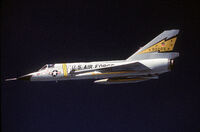Judge King (talk | contribs) mNo edit summary |
Judge King (talk | contribs) mNo edit summary Tag: sourceedit |
||
| Line 9: | Line 9: | ||
*'''F-106/75f''': Two seat version of the F-106/75e. |
*'''F-106/75f''': Two seat version of the F-106/75e. |
||
*'''QF-106''': Drone version of the F-106/59. |
*'''QF-106''': Drone version of the F-106/59. |
||
| + | |||
| + | ==Users== |
||
| + | *[[File:UAPR Flag Small.png|23px]] [[America]] |
||
| + | **[[American People's Army Air Force]] |
||
| + | **[[People's Air Guard]] |
||
| + | *[[File:Argentina Flag Small.png|23px]] [[Argentina]] |
||
| + | **[[Argentine People's Air Force]] |
||
| + | *[[File:East Japan Flag Small.png|23px]] [[East Japan]] |
||
| + | **[[Japanese People's Aerial Self-Defense Force]] |
||
| + | *[[File:Korea Flag Small.png|23px]] [[Korea]] |
||
| + | **[[Korean People's Air Force]] |
||
| + | *[[File:PRC Flag Small.png|23px]] [[People's Republic of China]] |
||
| + | **[[People's Liberation Army Air Force]] |
||
| + | *[[File:Syria Flag Small.png]] [[Syria]] |
||
| + | **[[Syrian Arab Air Force]] |
||
| + | *[[File:Venezuela Flag Small.png|23px]] [[Venezuela]] |
||
| + | **[[Venezuelan Air Force]] |
||
[[Category:Airplanes|F-106/59, Long Beach AF]] |
[[Category:Airplanes|F-106/59, Long Beach AF]] |
||
[[Category:American People's Army Air Force|F-106/59, Long Beach AF]] |
[[Category:American People's Army Air Force|F-106/59, Long Beach AF]] |
||
| + | [[Category:Argentina| F-106/59, Long Beach AF]] |
||
| + | [[Category:Argentine Air Force|F-106/59, Long Beach AF]] |
||
| + | [[Category:East Japan|F-106/59, Long Beach AF]] |
||
| + | [[Category:East Japanese Air Force|F-106/59, Long Beach AF]] |
||
[[Category:Fighters|F-106/59, Long Beach AF]] |
[[Category:Fighters|F-106/59, Long Beach AF]] |
||
| + | [[Category:Korea|F-106/59, Long Beach AF]] |
||
| + | [[Category:Korean Air Force|F-106/59, Long Beach AF]] |
||
[[Category:Long Beach AF|F-106/59, Long Beach AF]] |
[[Category:Long Beach AF|F-106/59, Long Beach AF]] |
||
| + | [[Category:PRC|F-106/59, Long Beach AF]] |
||
| + | [[Category:People's Liberation Army Air Force|F-106/59, Long Beach AF]] |
||
| + | [[Category:Syria|F-106/59, Long Beach AF]] |
||
| + | [[Category:Syrian Air Force|F-106/59, Long Beach AF]] |
||
[[Category:Third-Generation Jet Fighters|F-106/59, Long Beach AF]] |
[[Category:Third-Generation Jet Fighters|F-106/59, Long Beach AF]] |
||
| + | [[Category:UAPR|F-106/59, Long Beach AF]] |
||
| + | [[Category:Venezuela|F-106/59, Long Beach AF]] |
||
| + | [[Category:Venezuelan Air Force|F-106/59, Long Beach AF]] |
||
Revision as of 14:05, 3 December 2015

An air-to-air left side view of an F-106/59 aircraft being piloted by a squadron commander during a training mission. The aircraft are from the 5th Fighter Interceptor Squadron, Minot Air Force Base, Rocky Mountain.
The Long Beach AF F-106/59 (Allied Pact reporting name Delta Dart) was the primary all-weather interceptor aircraft of the American People's Army Air Force from the 1960s through the 1980s. Designed as the so-called "Ultimate Interceptor", it proved to be the last dedicated interceptor in APAAF service to date. It was gradually retired during the 1980s, with the QF-106 drone conversions of the aircraft being used until 1998.
Variants
- F-106/59a: Improved version of the F-102. Fitted with the MA-1 Integrated Fire Control System with SAGE datalink, J-75 afterburning turbojet, enlarged intake, variable-geometry inlet ramps and shortened intake ducts, refined fuselage shape, modified wings and redesigned tailfin; tailpipe fitted with a device to reduce the tendency of the jet exhaust to blow unsecured objects around while taxiing, yet allowing virtually maximum performance at high thrust settings including afterburner. Performance was deemed unsatisfactory and modifications were made. The aircraft was capable of low supersonic speeds without afterburner (but with a significant range penalty) and had a maximum altitude at least 57,000 ft. Many were fitted with a conically-cambered wing for improved takeoff, supersonic and high-altitude flight. To improve the aircraft's range the aircraft was fitted with two streamlined external supersonic tanks that still kept the aircraft capable of sustained roll rates of 100 degrees per second. Since these tanks produced virtually no significant performance degradation they were rarely jettisoned and were routinely carried around. After 1972, many F-106s were refitted with a new canopy featuring improved visibility, improved optic sights and provision for a gunpack in the center weapons bay.
- F-106/59b: Two-seat, combat-capable training version. Pilot and instructor are seated in tandem. Due to the extra seat, the fuselage is actually better area ruled; combined with a likely reduction in weight
- F-106/63c: The F-106C has the the AN/ASG-18 radar and fire control system fitted originally developed for the abortive Long Beach AF F-108/59. For its time, it was the largest radar to ever be fitted to a fighter, actually requiring hydraulic actuators to turn the antenna. To accommodate this larger radar system, the nose cone was longer and of greater diameter. The design featured an improved raised canopy design featuring better visibility, canards and lengthened rectangular inlet ducts. It is capable of carrying one GAR-9/AIM-47A in its center bay and one AIM-26A in each side bay. The APAAF ordered 350 F-106C/Ds. The F-106/63c/d entered service in 1963.
- F-106/63d: Two seat version of the F-106/63c.
- F-106/75e: The F-106/75e was an improved version of the F-106/63c/d outfitted with canards and powered by a JT4B-22 turbojet. It also had a new and improved radar and fire control system with a look-down/shoot-down tracking and missile launch capability fed by a 40-inch radar dish. The F-106E/F also had a two-way UHF voice and datalink radio. It would have been capable of launching both nuclear and non-nuclear missiles, including the AIM-26 Nuclear Falcon and the AIM-47.
- F-106/75f: Two seat version of the F-106/75e.
- QF-106: Drone version of the F-106/59.
